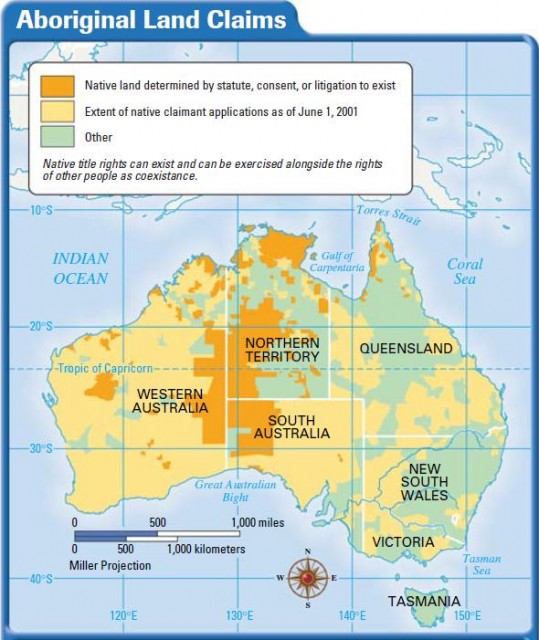Southeast Asia, Oceania, and Antarctica: Aboriginal Land Claims
A HUMAN PERSPECTIVE In 1972, the Australian government denied the claims of some Aboriginal people trying to regain ancestral lands. In response, Aboriginal protesters erected a tent on the lawn of Old Parliament House in Canberra and named it the Aboriginal Tent Embassy. They called it an embassy to symbolize their treatment as foreigners in their own country. They chose a temporary shelter instead of a building to symbolize that they had no permanent title to land.
Over the years, the Australian government tried to get rid of the tent embassy by force, by legal action, and by ignoring it in the hope that it would disappear. But in the year 2000, the embassy still stood. Protesters also set up a second tent embassy in Sydney during the Olympics to inform the world of their ongoing struggle to regain land.
Aboriginal People Lose Land
Traditionally, the Aboriginal people had a complex relationship with land. They didn't farm or herd animals but lived by hunting and gathering whatever was available for food. Because of this, they depended completely on nature and saw many places as sacred.
BRITISH POLICY
Because Aboriginal people did not use the land in the way that Westerners did—by farming it, mining it, and building on it—British colonists believed that they had no ties to the land. British authorities declared Australia to be Terra Nullius, a Latin term that means empty land. Therefore, the British government decided it had the right to take land without making treaties with Aboriginal leaders.
STOLEN LAND
When Europeans began to settle Australia in 1788, they chose the most fertile regions. Aboriginal people tried to fight what they saw as an invasion of their land, but they were defeated because the Europeans had superior weapons. Some Aboriginal people were forced to live on reserves, that is, tracts of less productive land set aside for them. Others lived on the edges of settlements and adopted some European ways, such as working on ranches.
STOLEN CHILDREN
The Aboriginal people lost something even more precious than land. Between 1909 and 1969, the Australian government took about 100,000 mixed-race children and gave them to white families to promote assimilation. Assimilation occurs when a minority group gives up its culture and adopts the majority group's culture.
Today, Aboriginal people call those children the Stolen Generation and feel great anger over their loss. Many Aboriginal people are fighting assimilation by passing their culture on to their children. And one reason they are seeking to regain land is to preserve their way of life.
Land Claims
In recent decades, the Aboriginal people have made some progress in winning their rights and regaining ownership of some of their land.
HARD-WON VICTORIES
The Aboriginal people were not recognized as full citizens of Australia until 1967. In that year, 91 percent of the Australian people voted to allow the federal government to pass special laws about Aboriginal rights.
The Land Rights Act of 1976 gave Aboriginal people the right to claim land in the Northern Territory. As a result, Aboriginal people gained ownership of the reserves where they were living and some unoccupied land that the government had owned.

THE MABO CASE
In 1992, the High Court of Australia handed down a decision that had a tremendous effect on land claims. The case involved Eddie Mabo, a Torres Strait Islander.
Mabo had been shocked to learn that under Australian law, his family did not own their traditional lands in the Murray Islands. But because the Mabos had worked the land for generations, the High Court upheld Eddie Mabo's claim. By reaching that decision in the Mabo Case, the Court recognized that Aboriginal people had owned land before the British arrived.
So the Mabo case overturned the doctrine of Terra Nullius, by which Britain originally took the land.
THE WIK CASE
In 1996, the High Court decided another important case. The Wik people, an Aboriginal group, claimed land that some ranchers and mining companies were using. The case involved two issues that are unique to landholding in Australia.
- The government still owns huge chunks of Australia. Ranchers take out pastoral leases, in effect renting the land from the government.
- In earlier cases, Aboriginal people had to prove their traditional relationship to a piece of land in order to claim it.
Aboriginal people could not use land that was taken up by farming or ranching, so it was hard to prove they had a tie to such land. And before 1996, white Australians assumed that pastoral leases wiped out any native land claims. But in the Wik Case, the court ruled that Aboriginal people could claim land held under a pastoral lease.
As a result, many white Australians feared having to pay Aboriginal people for land use or even losing access to some land altogether. So the national government amended the Wik decision to wipe out many Aboriginal land claims. In response, Aboriginal groups threatened lawsuits.
No one knows how the issue will be resolved. In Section 2, you will read about industrialization, another issue related to land use.
- Australia, New Zealand, and Antarctica
- Southeast Asia, Oceania, and Antarctica: Human–Environment Interaction
- Southeast Asia, Oceania, and Antarctica: Climate and Vegetation